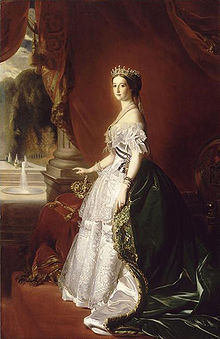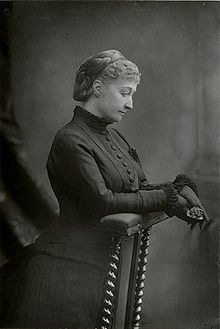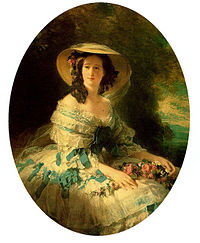- Eugénie de Montijo
-
Eugénie de Montijo Empress consort of the French
Countess of Teba and Marquise of Ardales
Portrait by Franz Winterhalter Tenure 30 January 1853 – 11 January 1871 Spouse Napoleon III of France Issue Napoléon Eugène, Prince Imperial Full name María Eugenia Ignacia Augustina de Palafox Portocarrero de Guzmán y Kirkpatrick House House of Bonaparte Father Cipriano de Palafox y Portocarrero Mother María Manuela Enriqueta Kirkpatrick de Closbourn y de Grevigné Born 5 May 1826
Granada, SpainDied 11 July 1920 (aged 94)
Madrid, SpainBurial Saint Michael's Abbey, Farnborough Signature 
Styles of
Empress Eugénie of France as consort
Reference style Her Imperial Majesty Spoken style Your Imperial Majesty Alternative style Madame Doña María Eugenia Ignacia Augustina de Palafox-Portocarrero de Guzmán y Kirkpatrick, 16th Countess of Teba and 15th Marquise of Ardales; 5 May 1826 – 11 July 1920), known as Eugénie de Montijo (French pronunciation: [øʒeni də montixo]), was the last Empress consort of the French from 1853 to 1871 as the wife of Napoleon III, Emperor of the French.
Contents
Empress
The last Empress of the French was born in Granada, Spain, to Don Cipriano de Palafox y Portocarrero (1785–1839), 9th Count of Montijo Grandee of Spain, 14th Marquis of Ardales, 17th Marquess of Moya, 13th Marquis of la Algaba, 15th Count of Teba, 8th Count of Fuentidueña and ?th Count of Ablitas,[1] and his half-Scottish, quarter-Belgian, quarter-Spanish wife (m. 15 December 1817), María Manuela Enriqueta Kirkpatrick de Closbourn y de Grevigné (24 February 1794 – 22 November 1879), a daughter of the Scots-born William Kirkpatrick of Closbourn (1764–1837), who became U. S. Consul to Málaga and later was a wholesale wine merchant, and his wife Marie Françoise de Grevignée (b. 1769), daughter of Liège-born Henri, Baron de Grevignée (baptised Notre-Dame-aux-Fonts, Liège, 2 June 1744) and wife (m. Málaga, 1766) Spanish-born doña Francisca Antonia Gallegos (1751–1853).
Eugenia's older sister, María Francisca de Sales de Palafox Portocarrero y Kirkpatrick, also known as Paca (1825–1860), who inherited most of the family honours and was 12th Duchess of Peñaranda Grandee of Spain and 9th Countess of Montijo, title later ceded to her sister, married the Duke of Alba in 1849. Until her own marriage in 1853, Eugénie variously used the titles of Countess of Teba or Countess of Montijo, but some family titles were legally inherited by her elder sister, through which they passed to the House of Alba. After the death of her father Eugenia became the 9th Countess of Teba, and is named as such in the Almanach de Gotha (1901 edition). After Eugenia's demise all titles of the Montijo family came to the Fitz-Jameses (the Dukes of Alba and Berwick).
Eugénie de Montijo, as she became known in France, was educated in Paris, at the fashionable convent of the Sacré Cœur, where she received a Catholic education. When Prince Louis Napoléon became president of the Second Republic, she appeared with her mother at several balls given by the "prince-president" at the Elysée Palace; it was there that she met the future emperor, whom she wed on 30 January 1853, not long after he had been rebuffed in his attempts to marry first Princess Carola of Vasa (later Queen of Saxony), a granddaughter of the deposed King of Sweden Gustav IV Adolph, and then Queen Victoria's teenage niece, Princess Adelheid of Hohenlohe-Langenburg.
Controversial marriage
In a speech from the throne on 22 January, Napoleon III formally announced his engagement, saying, "I have preferred a woman whom I love and respect to a woman unknown to me, with whom an alliance would have had advantages mixed with sacrifices." The so-called love match was looked upon with some sarcastic comment in the United Kingdom. The Times wrote, "We learn with some amusement that this romantic event in the annals of the French Empire has called forth the strongest opposition, and provoked the utmost irritation. The Imperial family, the Council of Ministers, and even the lower coteries of the palace or its purlieus, all affect to regard this marriage as an amazing humiliation..." A 26-year-old Spanish countess, of legitimate title and ancient lineage, the British newspaper implied with ill-concealed mirth, was not considered good enough for the House of Bonaparte (only two generations removed from obscurity in Corsica).
On 16 March 1856, the empress gave birth to an only son, Napoléon Eugène Louis Jean Joseph Bonaparte, styled Prince Impérial.
When the empress wore the new cage crinolines in 1855, European fashion followed suit, and when she abandoned vast skirts at the end of the 1860s, at the encouragement of her legendary couturier, Charles Frederick Worth, the silhouette of women's dress followed her lead again. Eugénie's aristocratic elegance, splendour of dress and legendary jewels are well documented in innumerable paintings, especially by her favourite portraitist, Franz Winterhalter.
Her husband often consulted her on important questions, and she acted as Regent during his absences in 1859, 1865 and 1870. A Catholic and a conservative, Eugénie's influence countered any liberal tendencies in the emperor's policies. She was a staunch defender of papal temporal powers in Italy and of ultramontanism.
She was also largely blamed for the fiasco of the French intervention in Mexico and the eventual death of Emperor Maximilian I of Mexico. Critics claimed that she had encouraged French involvement as a means of keeping herself busy and to get over her husband's affairs.[2]
After the Franco-Prussian War
When the Second French Empire was overthrown after France's defeat in the Franco-Prussian War (1870–1871), the empress and her husband took refuge in England, and settled at Chislehurst, Kent. After his death in 1873, and that of her son in 1879, she moved in 1885 to Farnborough, Hampshire, and to her villa "Cyrnos" (ancient Greek name of Corsica), that she had built at Cape Martin between Menton and Nice, where she lived in retirement, abstaining from all interference in French politics. Her house in Farnborough is now an independent Roman Catholic girls' school, Farnborough Hill.
After the deaths of her husband and son her health started to deteriorate. Her physician recommended she visit Bournemouth which was, in Victorian times, famed as a health spa resort. During her visit in 1896, a groundskeeper lit hundreds of little tea candles in the municipal Bournemouth Gardens to light her way to the sea at night. This event is still commemorated in the same gardens every September in an elaborate public display, set to music, of both static and floating lighted candles.[3]
The former empress died in July 1920, aged 94, during a visit to her relatives, the Dukes of Alba in Madrid, in her native Spain, and she is interred in the Imperial Crypt at St Michael's Abbey, Farnborough, with her husband and her son, who had died in 1879 fighting in the Zulu War in South Africa. She left all her possessions to various relatives: her Spanish estates went to the grandsons of her sister, the Fitz-Jameses (Dukes of Berwick and Alba), the house in Farnborough with all collections to the heir of her son, Prince Victor Bonaparte, Villa Cyrnos to his sister, Princess Laetitia of Aosta. Liquid funds were divided into three parts and given to the above relatives, except the sum of 100 000 francs bequeathed to the Committee for Rebuilding the Cathedral of Reims.
Her deposed family's friendly association with the United Kingdom was commemorated in 1887 when she became the godmother of Victoria Eugenie of Battenberg (1887–1969), daughter of Princess Beatrice, who later became Queen consort of Alfonso XIII of Spain. This baptism was an early example of ecumenism as Victoria Eugenie who was born at Balmoral was baptised in the Church of Scotland. A century later, the second daughter of the present Duke of York, born in 1990, was named Princess Eugenie.
Legacy
The Empress has also been commemorated in space; the asteroid 45 Eugenia was named after her,[4] and its moon, Petit-Prince, after the Prince Imperial.[5] The empress had an amazing jewellery collection, most of them were later owned by the Brazilian Aimee de Heeren.[6][7] Aimee de Heeren collected jewels and she was fond of the Empress as both of them were considered to be the "Queens of Biarritz". Both used to spend the summer on the cote basque, The Empress lived at the "Villa Eugenie", now called Hotel du Palais, Aimee de Heeren, a century later, in the "Villa La Roseraie".
In popular culture
Named for the Empress, the Eugénie hat is a style of women's chapeau worn dramatically tilted and drooped over one eye; its brim is folded up sharply at both sides in the style of a riding topper, often with one long ostrich plume streaming behind it.[8] The hat was popularized by film star Greta Garbo and enjoyed a vogue in the 1930s that was "hysterically popular".[9] More redolent of the Empress' actual apparel, however, was the late nineteenth-century fashion of the Eugénie paletot, a women's greatcoat with bell sleeves and a single button enclosure at the neck.[10]
Titles from birth to death
- Doña Maria Eugenia Ignacia Augustina Palafox de Guzmán Portocarrero y Kirkpatrick (May 5, 1826, from birth till her father's death)
- Her Excellency Doña Maria Eugenia Ignacia Augustina Palafox de Guzmán Portocarrero y Kirkpatrick, 19th Countess of Teba (1839, from her father's death till her wedding)
- Her Imperial Majesty The Empress of the French (1853–1870) as well as Her Imperial Majesty The Empress-Regent during several periods (including the Italian, Crimean and Franco-Prussian wars)
- Her Imperial Majesty Empress Eugénie of France (1870–1920)
She was the 475th Dame of the Royal Order of Queen María Luisa of Spain and Dame Grand Cross of the Order of the British Empire.
Ancestry
Ancestors of Eugénie de Montijo 16. Juan Antonio de Palafox, 5th Marquis of Ariza 8. Joaquín Antonio de Palafox, 6th Marquis of Ariza 17. Francisca Josefa Centurión, 4th Marquise of Armunia 4. Felipe Antonio de Palafox y Cröy d'Havré 18. Jean-Baptiste de Croÿ, 5th Duke of Havré 9. Princess Marie-Anne-Charlotte of Croÿ d'Havré 19. Princess Maria Anna Lante Montefeltro della Rovere 2. Cipriano de Palafox, 8th Count of Montijo 20. Cristóbal de Portocarrero, 5th Count of Montijo 10. Cristóbal de Portocarrero, 5th Marquis of Valderrábano 21. María Dominga Fernández de Córdoba y Portocarrero 5. Maríaa Francisca de Sales de Portocarrero, 6th Countess of Montijo 22. Antonio López de Zúñiga, 9th Duke of Peñaranda 11. María Josefa López de Zuñiga y Pacheco 23. María Teresa Pacheco y Álvarez de Toledo 1. Eugenia de Palafox Portocarrero de Guzmán y Kirkpatrick 24. Robert Kirkpatrick of Glenkiln 12. William Kirkpatrick of Closeburn 25. Henriette Gillespie 6. William Kirkpatrick of Closeburn 26. John Wilson of Kelton Castle 13. Mary Wilson 3. María Manuela Kirkpatrick de Closbourn 28. André de Grevigné 14. Henri de Grevigné 29. Marie-Josèphe Dehousse 7. Marie-Françoise de Grevigné 30. Antonio de Gallegos 15. Francisca Antonia de Gallegos Film portrayals
- In Suez 1938, where Loretta Young plays her as the love interest of Ferdinand de Lesseps.
- In Juarez 1939, as played by Gale Sondergaard, where she joins her husband in setting Austrian Archduke Maximilian on the throne of Mexico, and then abandoning him.
- In Violet Imperiales (1932 and 1952). At Granada, in 19th century Spain, Eugénie de Montijo (Simon Valérie) asks a gypsy girl, Violetta, to read her fortune in her hand. Emboldened by Violetta's prediction that she is to become a queen, Eugénie heads for Paris, accompanied by her Maria Manuela Kirkpatrick y Grivégnee.
- In The Song of Bernadette 1943, as played by Patricia Morison, she credits the waters of Lourdes with curing the Prince Imperial.
- In The Diving Bell and the Butterfly 2007, Emma de Caunes plays her during a fantasy sequence.
- In the 2009 mini-series Sisi, she is portrayed by a Hungarian actress Andrea Osvart.
See also
- Eugénie de Montijo Archipelago
References
- ^ Grandesp.or.uk. Genealogy of the Counts of Montijo
- ^ Maximilian and Carlota by Gene Smith, ISBN 0245524185, ISBN 978-0245524189
- ^ Bournemouth Gardens website
- ^ Schmadel, Lutz D.; International Astronomical Union (2003). Dictionary of minor planet names. Berlin; New York: Springer-Verlag. p. 19. ISBN 978-3-540-00238-3. http://books.google.com/books?id=KWrB1jPCa8AC&pg=PA19#v=onepage&q&f=false. Retrieved 18 September 2011.
- ^ "Solar System Exploration: Asteroids – Moons". National Aeronautics and Space Administration. 2011. http://solarsystem.nasa.gov/planets/profile.cfm?Object=Asteroids&Display=Moons. Retrieved 18 September 2011.
- ^ The Marguerite Necklace of Empress Eugenie and Aimee de Heeren
- ^ Aimee de Heeren wearing the Marguerite Necklace
- ^ Calasibetta, Charlotte Mankey; Tortora, Phyllis (2010). The Fairchild Dictionary of Fashion. New York: Fairchild Books. pp. 249–250. ISBN 978-1-56367-973-5. http://fairchildpub.files.wordpress.com/2009/08/fashion-dictionary-sample1.pdf. Retrieved 2011-09-18.
- ^ Shields, Jody (1991). Hats: A Stylish History and Collector's Guide. New York: Clarkson Potter. p. 43. ISBN 9780517574393. http://books.google.com/books?id=nkPrAAAAMAAJ.
- ^ Calasibetta, p. 93.
External links
Eugénie de MontijoBorn: 5 May 1826 Died: 11 July 1920French royalty Vacant Title last held byMarie Amalie of the Two Sicilies
as Queen of the FrenchEmpress of the French
30 January 1853–11 January 1871Monarchy abolished Spanish nobility Preceded by
Cipriano de Palafox y PortocarreroCountess of Teba
1839-1920Succeeded by
Eugenia María Fitz-James StuartMarquise of Ardales
1839-1920Succeeded by
Jacobo Fitz-James StuartQueens and Empresses of France Adelaide of Aquitaine (987–996) · Rozala of Italy (996) · Bertha of Burgundy (996–1000) · Constance of Arles (1003–1031) · Matilda of Frisia (1034–1044) · Anne of Kiev (1051–1060) · Bertha of Holland (1071–1092) · Bertrade de Montfort (1092–1108) · Adelaide of Maurienne (1115–1137) · Eleanor of Aquitaine (1137–1152) · Constance of Castile (1154–1160) · Adèle of Champagne (1164–1180) · Isabelle of Hainaut (1180–1190) · Ingeborg of Denmark (1193–1193; 1200-1223) · Agnes of Merania (1196–1200) · Blanche of Castile (1223–1226) · Margaret of Provence (1234–1270) · Isabella of Aragon (1270–1271) · Maria of Brabant (1274–1285) · Joan I of Navarre (1285–1305) · Margaret of Burgundy (1314–1315) · Clementia of Hungary (1315–1316) · Joan II of Burgundy (1316–1322) · Blanche of Burgundy (1322) · Marie of Luxembourg (1322–1324) · Jeanne d'Évreux (1325–1328) · Joan the Lame (1328–1348) · Blanche of Navarre (1350) · Joan I of Auvergne (1350–1360) · Jeanne de Bourbon (1364–1378) · Isabeau of Bavaria (1385–1422) · Marie of Anjou (1422–1461) · Charlotte of Savoy (1461–1483) · Anne of Brittany (1491–1498; 1498–1514) · Joan of France (1498) · Mary of England (1514-1515) · Claude of France (1515–1524) · Eleanor of Austria (1530–1547) · Catherine de' Medici (1547–1559) · Mary, Queen of Scots (1559–1560) · Archduchess Elisabeth of Austria (1570–1574) · Louise of Lorraine (1575–1589) · Margaret of Valois (1589–1599) · Marie de' Medici (1600–1610) · Archduchess Anne of Austria (1615–1643) · Archduchess Maria Theresa of Austria (1660–1683) · Marie Leszczyńska (1725–1768) · Archduchess Maria Antonia of Austria (1774–1792) · Princess Marie Joséphine of Savoy* (1795–1810) · Joséphine de Beauharnais (1804–1810) · Archduchess Marie Louise of Austria (1810–1814) · Princess Marie Thérèse of France* (1830) · Princess Maria Amalia of Naples and Sicily (1830–1848) · Eugénie de Montijo (1853–1870)*disputedCategories:- 1826 births
- 1920 deaths
- People from Granada
- People from Farnborough, Hampshire
- Empresses of the French
- French queens consort
- House of Bonaparte
- Regents of France
- Female regents
- French socialites
- Spanish nobility
- French people of the Franco-Prussian War
- Burials at St Michael's Abbey, Farnborough
- Recipients of the Golden Rose
- Dames of the Order of Queen Maria Luisa
- Honorary Dames Grand Cross of the Order of the British Empire
Wikimedia Foundation. 2010.



